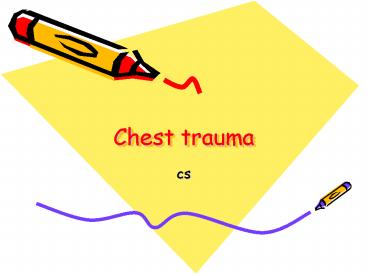Chest trauma - PowerPoint PPT Presentation
1 / 14
Title:
Chest trauma
Description:
Chest drainage 1500 ml or 200 ml per hour. Large unevacuated clotted haemothorax ... Chest wall defect. Massive air leak despite adequate drainage ... – PowerPoint PPT presentation
Number of Views:98
Avg rating:3.0/5.0
Title: Chest trauma
1
Chest trauma
- cs
2
Primary survey chest injuries
- Airway obstruction
- Tension pneumothorax
- Open pneumothorax
- Massive haemothorax
- Pericardial tamponade
3
Secondary survey chest injuries
- Pulmonary contusion
- Myocardial contusion
- Aortic disruption
- Traumatic diaphragmatic hernia
- Tracheobronchial disruption
- Oesophageal disruption
4
Management of the unstable patient
- Indications for emergency room thoracotomy
- Acute pericardial tamponade unresponsive to
cardiac massage - Exsanguinating intra-thoracic haemorrhage
- Intra-abdominal haemorrhage requiring aortic
cross clamping - Need for internal cardiac massage
5
Indications for urgent thoracotomy
- Chest drainage gt1500 ml or gt200 ml per hour
- Large unevacuated clotted haemothorax
- Developing cardiac tamponade
- Chest wall defect
- Massive air leak despite adequate drainage
- Proven great vessel injury on angiography
- Proven oesophageal injury
- Proven diaphragmatic laceration
- Traumatic sepal or valvular injury of the heart
6
Haemothorax
- Common after both penetrating and blunt trauma
- Pleural cavity can hold up to 3 litres of blood
- One litre may accumulate before apparent on chest
x-ray - 90 due to injury to internal mammary or
intercostal vessels - 10 from pulmonary vasculature
- Bleeding usually stops when lung re-expanded
- Most require no more than simple chest drainage
7
Pericardial tamponade
- Major complication of penetrating chest trauma
- Haemopericardium prevents diastolic filling of
the heart - Classic signs are Beck's triad
- Hypotension
- Venous distension
- Muffled heart sounds
- May be associated with pulsus paradoxus
- Chest x-ray shows a globular heart
- Unstable patient requires urgent thoracotomy
- In stable patient diagnosis can be confirmed by
- Echocardiography
- Pericardiocentesis
- Subxiphoid pericardiotomy is both a diagnostic
and therapeutic procedure
8
Cardiac stab wounds
- Right side of the heart is more commonly injured
- Patients with right ventricular wound is more
like to survive than with left sided injury - Atria, inflow and outflow tracts may also be
damaged - Patients usually presents with pericardial
tamponade - Treatment consists of resuscitation and
pericardiocentesis - Stab wounds can be accessed via a median
sternotomy - Can be directly repaired without cardiopulmonary
bypass - Teflon-pledgeted prolene sutures are generally
used
9
Injuries to the great vessels
- Suspect possibility of injury from the mechanism
or site of penetrating injury - Usually present with shock or pericardial
tamponade - Chest x-ray may show
- Widening of the mediastinum to greater than 8 cm
- Depression of the left main bronchus to greater
than 140 degrees - Haematoma in the left apical area
- Massive left haemothorax
- Deviation of oesophagus ton the right
- Loss of aortic knob contour
- Loss of paraspinal pleural stripe
- Requires emergency thoracotomy or sternotomy
- Injuries to descending thoracic aorta require
left anterior thoracotomy - Injuries to proximal aorta and proximal carotid
arteries require median sternotomy
10
Flail chest
- Flail chest is associated with multiple rib
fractures on the same side - Flail segment does not have continuity with
remainder of thoracic cage - Results in paradoxical chest wall movement with
respiration - Often associated with underlying pulmonary
contusion - Paradoxical movement results in impaired
ventilation - The work of breathing is increased
- Ventilation perfusion mismatch and arterio-venous
shunting occurs
11
Chest x-ray will show
- Multiple rib fractures
- Underlying lung contusion
- Haemopneumothorax
- Other associated injuries
12
Treatment requires
- Adequate ventilation
- Humidified oxygen
- Adequate analgesia
13
Consider intubation and ventilation if
- Significant other injuries (ISS gt50)
- Respiratory rate more than 35 per min
- Partial pressure oxygen less than 8.0 kPa
- Partial pressure carbon dioxide greater than 6.6
kPa - Vital capacity less than 12 ml / kg
- Right to left shunt of more than 15
- Operative fixation is not normally required
14
(No Transcript)































